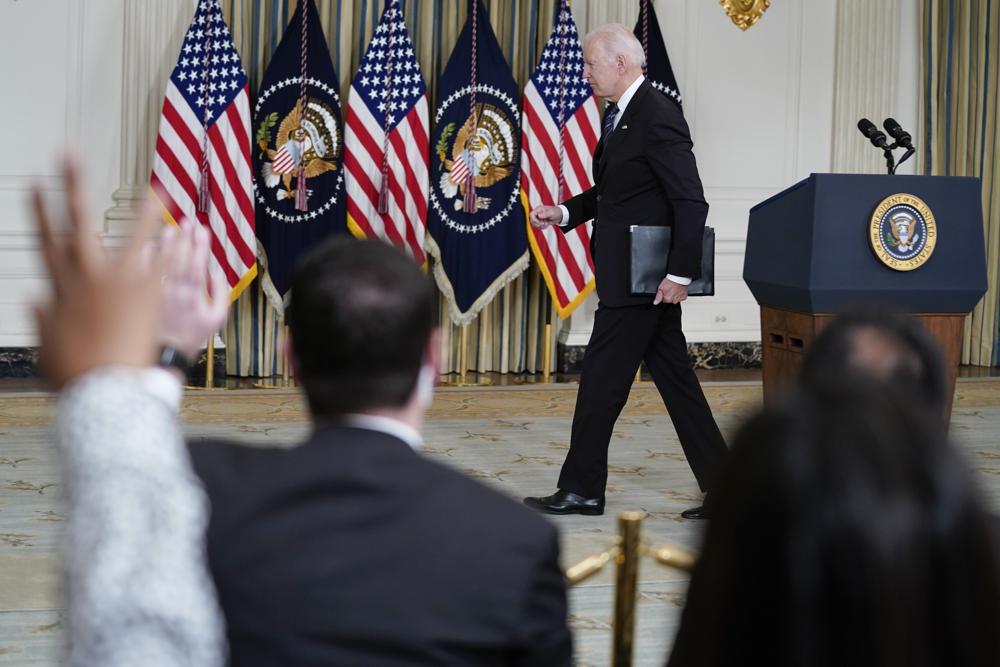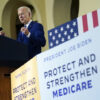FILE – President Joe Biden departs after speaking about the October jobs report from the State Dining Room of the White House, Nov. 5, 2021, in Washington. As President Joe Biden wraps up his first year in the White House, he has held fewer news conferences than any of his five immediate predecessors at the same point in their presidencies, and has taken part in fewer media interviews than any of his recent predecessors. That’s according to new research from Towson University professor emerita Martha Joynt Kumar. (AP Photo/Evan Vucci, File)
WASHINGTON (AP) — In what’s become a familiar scene President Joe Biden lingered after delivering a recent speech on the pandemic as reporters fired a barrage of questions.
He bristled at a query about the shortage of COVID-19 rapid tests, answered another about omicron-spurred travel restrictions and sidestepped a third about whether Sen. Joe Manchin failed to keep his word when he torpedoed Biden’s social services and climate spending plan.
“I’m not supposed to be having this press conference right now,” Biden said at the end of a meandering response that didn’t directly answer the question about the West Virginia Democrat.
Seconds later, Biden turned and walked out of the room, abruptly ending what’s become the president’s preferred method for his limited engagements with the press.
As Biden wraps up his first year in the White House, he has held fewer news conferences than any of his five immediate predecessors at the same point in their presidencies, and he has taken part in fewer media interviews than any of his recent predecessors.
The dynamic has left the White House facing questions about whether the president, who vowed to have the most transparent administration in the nation’s history, is falling short in pulling back the curtain on how his administration operates and missing opportunities to explain his agenda to Americans.
Biden does more frequently field questions at public appearances than any of his recent predecessors, according to new research published by Martha Joynt Kumar, a professor emerita in political science at Towson University and director of the White House Transition Project.
He routinely pauses to talk to reporters who shout questions over Marine One’s whirring propellers as he comes and goes from the White House. He parries with journalists at Oval Office photo ops and other events. But these exchanges have their limitations.
“While President Biden has taken questions more often at his events than his predecessors, he spends less time doing so,” Kumar notes. “He provides short answers with few follow-ups when he takes questions at the end of a previously scheduled speech.”
Biden has done just 22 media interviews, fewer than any of his six most recent White House predecessors at the same point in their presidencies.
The 46th president has held just nine formal news conferences — six solo and three jointly with visiting foreign leaders. Ronald Reagan, whose schedule was scaled back early in his first term after he recovered after a failed assassination attempt, is the only recent president to hold fewer press conferences during his first year in office, according to Kumar. Reagan did 59 interviews in 1981.
Former President Donald Trump, who regularly pilloried the media, did 92 interviews in his first year in office, more than two dozen of those with friendly interlocutors at Fox News. But Trump also held lengthy sessions with ABC News, The Associated Press, the New York Times, Reuters and other outlets whose coverage he impugned over the course of his presidency.
Biden’s 22 media interviews have included one-on-one sessions with journalists at three of the major television networks, two CNN town halls, an appearance on MSNBC, a trio of regional television interviews via Zoom, as well as conversations with late night host Jimmy Fallon and ESPN’S Sage Steele. He’s given just three print interviews.
The White House has fielded requests from media outlets — and complaints from the White House Correspondents’ Association — for Biden to do more one-on-one interviews and formal news conferences.
White House press secretary Jen Psaki has pushed back that journalists don’t need an “embroidered cushion” to engage Biden because he has not shied away from taking questions from reporters at public events.
But such exchanges often don’t lend themselves to follow-up questions. The president can ignore questions he might not want to answer.
“Fleeting exchanges are insufficient to building the historical record of the president’s views on a broad array of public concerns. We have had scant opportunities in this first year to learn the president’s views on a broad range of public concerns,” said Steven Portnoy, president of the White House Correspondents’ Association and a reporter for CBS New Radio. “The more formal the exchange with the press, the more the public is apt to learn about what’s on the man’s mind.”
The president has answered questions at 55% of events where he’s delivered remarks or an address during his first year in office, more than even two of the more loquacious presidents, Bill Clinton (48%) and Trump (41%).
White House officials pointed to such frequent interactions with reporters as evidence that Biden has demonstrated a commitment to transparency. Officials also suggested that the ongoing pandemic has also had an impact on the number of interviews and news conference in the administration’s first year.
“I think that we have been very transparent,“ White House principal deputy press secretary Karine Jean-Pierre said. “I don’t think you can just piecemeal and I think you have to look at it as a whole.”
Trump had regular, and sometimes lengthy exchanges, with reporters as a thwapping Marine One awaited him on the South Lawn.
The tradition of “chopper talk,” a nickname coined by late-night host Stephen Colbert for strained exchanges, has continued with Biden. The current president, however, tends to keep the exchanges brief.
Such informal exchanges offer a less than ideal dynamic for reporters trying to glean insight about Biden’s thinking on issues of national and global import. It’s also easy for the president to ignore a question he doesn’t want to answer.
At other moments, Biden has used the exchanges to drive the news cycles with just a few words.
Asked by a reporter after his private visit with Pope Francis at the Vatican in October whether the issue of abortion came up, Biden responded that it didn’t. He then quickly pivoted to asserting that Francis told him he was “a good Catholic and I should keep receiving communion.” The entire back-and-forth with reporters lasted about a minute.
The administration has put a premium on finding ways to speak to Americans where they are as it tries to maximize the president’s limited time for messaging efforts, according to a White House official who spoke on the condition of anonymity to discuss the administration’s communications strategy.
To that end, Biden has been interviewed by YouTube personality Manny Mua and went on the “The Tonight Show” to push his domestic agenda and encourage Americans to get vaccinated. The White House believes such platforms can help the president more easily reach middle-class workers or young Americans who aren’t glued to the cable networks or The New York Times.
Biden has also leaned on celebrities with big social media followings — including actress and songwriter Olivia Rodrigo and Bill Nye The Science Guy — who have done videos with Biden to help bolster his vaccination push and plug his major domestic spending initiatives.
Biden is hardly the first president to look beyond the mainstream media to try to connect with Americans.
Former President Barack Obama appeared on Zach Galifianakis’s “Between Two Ferns” to help sell his signature health care law and visited comedian Marc Maron’s garage to record an episode on the popular WTF podcast days after the 2015 Charleston church shooting. In the wide-ranging Maron interview, Obama spoke bluntly about racism.
Trump frequently called into Fox News’ early morning and evening opinion shows, programming that allowed him to reach his base without the filter of journalists.
Brian Ott, a Missouri State University communications professor who studies presidential rhetoric, said the scarcity of Biden news conferences and interviews with mainstream press may help explain why Biden’s approval ratings are near historic lows even though most polls show that much of his domestic agenda remains popular with a majority of Americans.
While pop culture and social media offer the president opportunities to connect with a segment of America, Ott said, the president connecting to the electorate through traditional broadcast and print news outlets — and holding formal news conferences — will be critical to correcting that disconnect.
“The presidency has always been a predominantly rhetorical enterprise,” Ott said. “You can’t drive an agenda without vision casting and part of that has to go through the mainstream press.”
Associated Press writer Darlene Superville contributed reporting.
Copyright 2021 Associated Press. All rights reserved.









































